You may get the Your Remote Desktop Services session has ended error when you try to use a remote desktop after updating your Windows 11/10 computer. This post offers practical fixes that you can apply to resolve the issue.
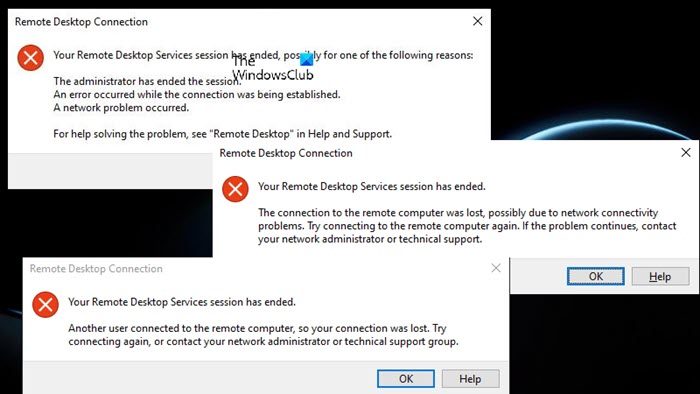
When this issue occurs, the following full error message is displayed:
Error message 1
Your Remote Desktop Services session has ended, possibly for one of the following reasons:
- The administrator has ended the session.
- An error occurred while establishing the connection.
- There is a network problem.
Apart from this error message, you may get the following similar or related error message description as to why Your Remote Desktop Services session has ended:
Error message 2
The connection to the remote computer was lost, possibly due to network connectivity problems.
Error message 3
Another user connected to the remote computer, so your connection was lost
You’re likely to encounter these errors due to the following reasons:
- Automatic login.
- Bad Windows update.
- Incompatibility issues with the WDDM graphics driver.
- Incorrect network connection profile.
- Remote session conflict:
Your Remote Desktop Services session has ended
If you get any of the error messages that indicate Your Remote Desktop Services session has ended when you try to connect or establish a remote desktop connection, then the solutions we have presented below can help you resolve the issue.
Let’s see these fixes in detail. Fix 1-4 applies to Error message 1, while Fix 5 and 6 apply to Error messages 2 and 3 respectively.
- Disable UDP (User Datagram Protocol)
- Disable the WDDM graphics driver
- Uninstall recent Windows update
- Disable automatic login
- Change the network profile
- Modify GPO on the server machine
Let’s see these solutions in detail.
1] Disable UDP (User Datagram Protocol)
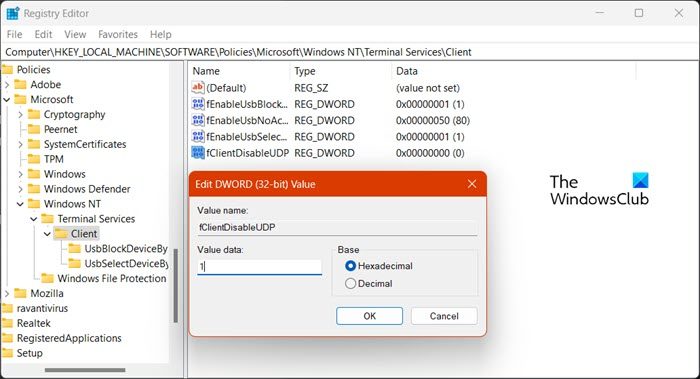
The Your Remote Desktop Services session has ended error message can be resolved by disabling UDP (User Datagram Protocol) on the client machine. You can do this in either of the three following ways.
PowerShell
- Open Windows Terminal in admin mode.
- Run the following command:
New-ItemProperty 'HKLM:\SOFTWARE\Microsoft\Terminal Server Client' -Name UseURCP -PropertyType DWord -Value 0
Registry
- Press Windows key + R to invoke the Run dialog.
- In the Run dialog box, type regedit and hit Enter to open Registry Editor.
- Navigate or jump to the registry key path below:
HKEY_LOCAL_MACHINE\SOFTWARE\Policies\Microsoft\Windows NT\Terminal Services\Client
- At the location, on the right pane, double-click the fClientDisableUDP entry to edit its properties.
If the key is not present, right-click on the blank space on the right pane and then select New > DWORD (32-bit) Value to create the registry key, and then rename the key accordingly and hit Enter.
- Double-click on the new entry to edit its properties.
- Type 1 in the Value data field.
- Click OK or hit Enter to save the change.
- Exit Registry Editor.
- Restart the machine.
Group Policy
- Open the Run dialog.
- In the Run dialog box type gpedit.msc and press Enter to open the Local Group Policy Editor.
- Now, navigate to the path below:
Computer Configuration > Administration Templates > Windows Components > Remote Desktop Services > Remote Desktop Connection Client
- On the right pane, double-click on Turn off UDP on Client to edit its properties.
- Now, set the radio button to Enabled.
- Click Apply > OK to save the changes.
- Exit the Local Group Policy Editor.
- Restart your computer.
Read: Your computer can’t Connect to the remote computer
2] Disable the WDDM graphics driver
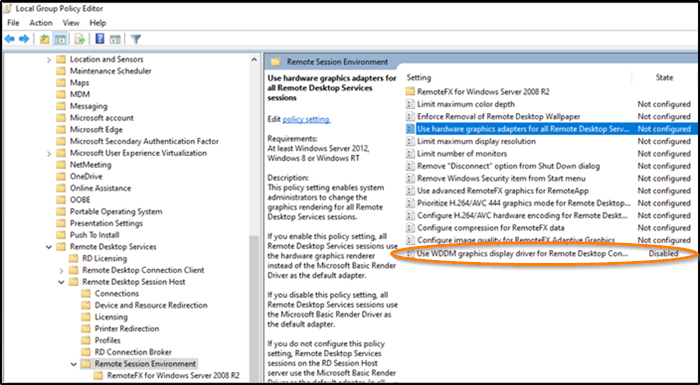
Do the following,
- Open Local Group Policy Editor.
- Next, navigate to the path below:
Computer Configuration > Administrative Templates > Windows Components > Remote Desktop Services > Remote Desktop Session Host > Remote Session Environment
- On the right pane, double-click on Use WDDM graphics display driver for Remote Desktop Connections to edit its properties.
- Now, set the radio button to Disabled.
- Click Apply > OK to save the changes.
- Exit the Local Group Policy Editor.
- Restart your computer.
Read: Remote Desktop not working in Windows 11
3] Uninstall the recent Windows update
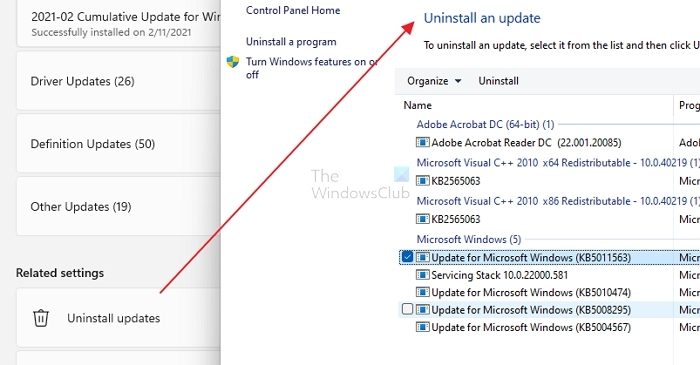
If you started experiencing the issue after you recently updated the machine, then in this case, to resolve the issue, you can uninstall the Windows update. Alternatively, you can perform System Restore.
4] Disable automatic login
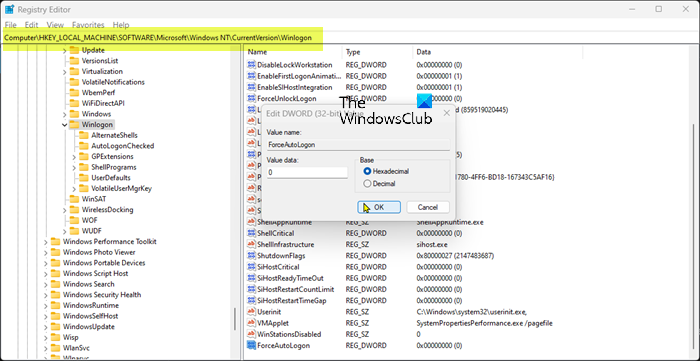
To perform this task, do the following:
- Open Registry Editor.
- Navigate or jump to the registry key path below:
HKEY_LOCAL_MACHINE\SOFTWARE\Microsoft\Windows NT\CurrentVersion\Winlogon
- At the location, on the right pane, locate and double-click the ForceAutoLogon entry to edit its properties.
If the key is not present, right-click on the blank space on the right pane, select New > DWORD (32-bit) Value to create the registry key, and then rename the key accordingly, and hit Enter.
- Double-click on the new entry to edit its properties.
- Input 0 in the Value data field.
- Click OK or hit Enter to save the change.
- Exit Registry Editor.
- Restart the machine.
Read: Windows Auto login is not working [Fixed]
5] Change the network profile
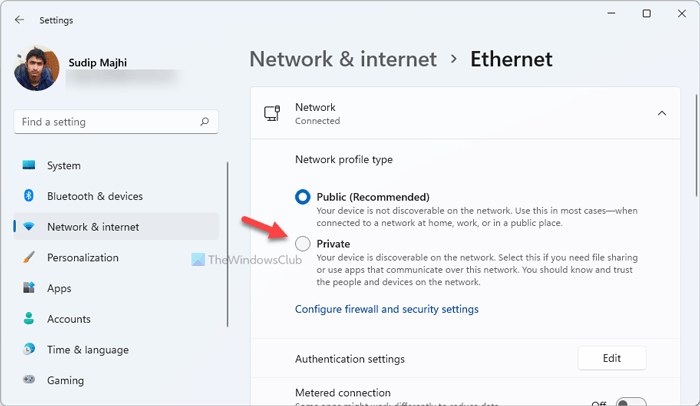
This solution requires you to change the network profile from Public to Private.
6] Modify GPO on the server machine
To perform this task, do the following:
- Open Local Group Policy Editor.
- Next, navigate to the path below:
Computer Configuration > Administrative Templates > Windows Components > Remote Desktop Services > Remote Desktop Session Host > Connections.
- On the right pane, double-click on Restrict Remote Desktop Services users to a single Remote Desktop Services session to edit its properties.
- Now, set the radio button to Disabled.
- Click Apply > OK to save the changes.
- Exit the Local Group Policy Editor.
- Restart your computer.
Read: How to increase the number of Remote Desktop Connections
We hope this helps!
What causes RDP disconnects?
The RD session disconnected problem may occasionally be brought on by incorrectly configured Group Policy settings or RDP-TCP settings in the Remote Desktop Services Configuration, which could restrict the number of sessions permitted. Conflicting port assignments: RDP’s default port number is 3389.
Read: No Remote Desktop License Servers; Remote session disconnected
What happens when you disconnect an RDP window without closing the session?
Applications in a remote desktop can still be running if you disconnect from it without signing out. You can also cut off your connection to a server and continue using published programs. There is a limit on RDP sessions that without a license, only 2 simultaneous RDP connections are allowed.
Read next: Your computer could not connect to another console session.
Leave a Reply